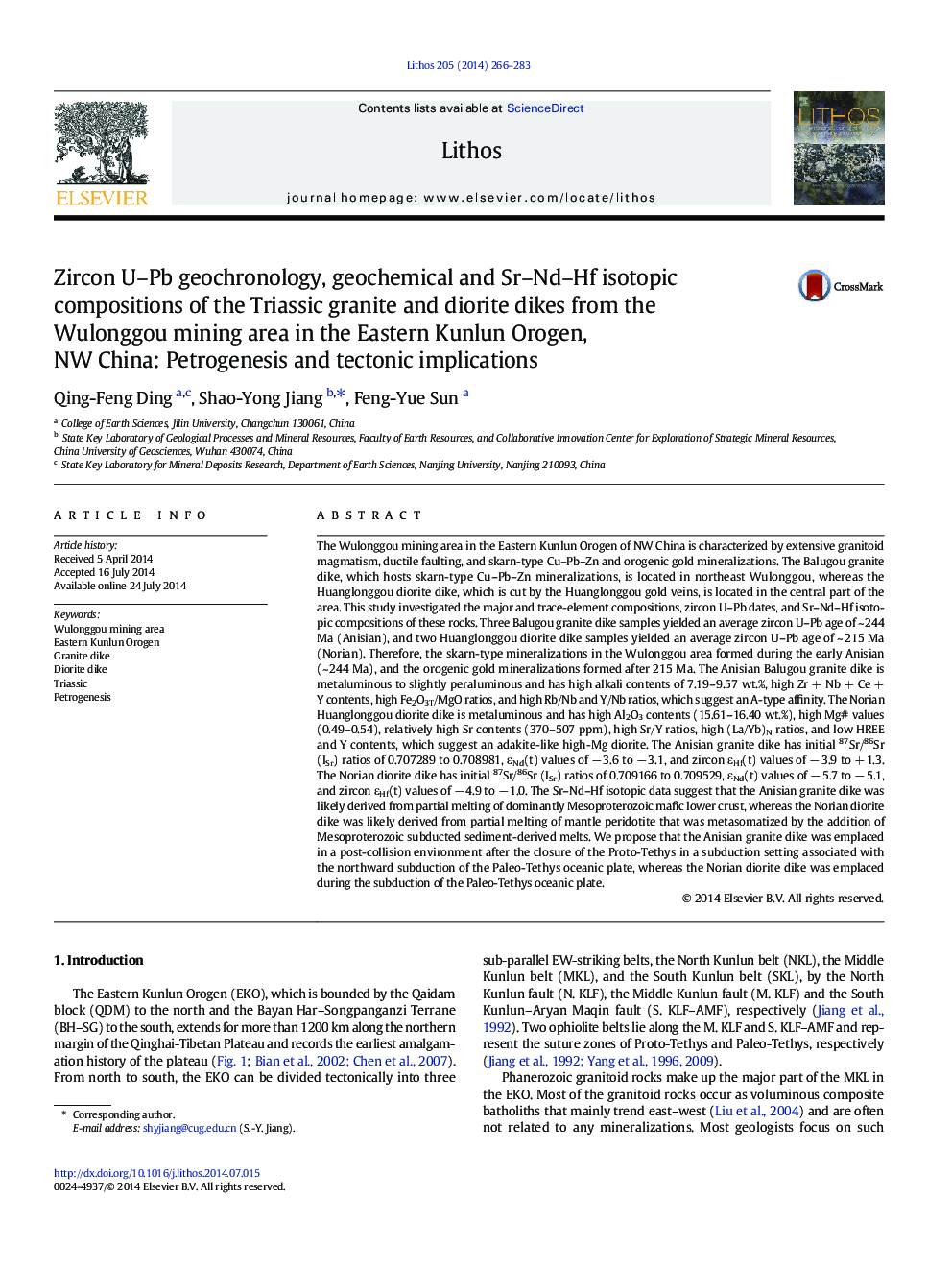| کد مقاله | کد نشریه | سال انتشار | مقاله انگلیسی | نسخه تمام متن |
|---|---|---|---|---|
| 4715836 | 1638673 | 2014 | 18 صفحه PDF | دانلود رایگان |

• The Balugou granite dike hosting the skarn-type mineralizations yielded a zircon U–Pb age of 244 Ma (Anisian).
• The Huanglonggou diorite dike cut by the orogenic gold mineralizations yielded a zircon U–Pb age of 215 Ma (Norian).
• The Anisian Balugou granite dike has an A-type affinity.
• The Norian Huanglonggou diorite dike belongs to an adakite-like high-Mg diorite.
The Wulonggou mining area in the Eastern Kunlun Orogen of NW China is characterized by extensive granitoid magmatism, ductile faulting, and skarn-type Cu–Pb–Zn and orogenic gold mineralizations. The Balugou granite dike, which hosts skarn-type Cu–Pb–Zn mineralizations, is located in northeast Wulonggou, whereas the Huanglonggou diorite dike, which is cut by the Huanglonggou gold veins, is located in the central part of the area. This study investigated the major and trace-element compositions, zircon U–Pb dates, and Sr–Nd–Hf isotopic compositions of these rocks. Three Balugou granite dike samples yielded an average zircon U–Pb age of ~ 244 Ma (Anisian), and two Huanglonggou diorite dike samples yielded an average zircon U–Pb age of ~ 215 Ma (Norian). Therefore, the skarn-type mineralizations in the Wulonggou area formed during the early Anisian (~ 244 Ma), and the orogenic gold mineralizations formed after 215 Ma. The Anisian Balugou granite dike is metaluminous to slightly peraluminous and has high alkali contents of 7.19–9.57 wt.%, high Zr + Nb + Ce + Y contents, high Fe2O3T/MgO ratios, and high Rb/Nb and Y/Nb ratios, which suggest an A-type affinity. The Norian Huanglonggou diorite dike is metaluminous and has high Al2O3 contents (15.61–16.40 wt.%), high Mg# values (0.49–0.54), relatively high Sr contents (370–507 ppm), high Sr/Y ratios, high (La/Yb)N ratios, and low HREE and Y contents, which suggest an adakite-like high-Mg diorite. The Anisian granite dike has initial 87Sr/86Sr (ISr) ratios of 0.707289 to 0.708981, εNd(t) values of − 3.6 to − 3.1, and zircon εHf(t) values of − 3.9 to + 1.3. The Norian diorite dike has initial 87Sr/86Sr (ISr) ratios of 0.709166 to 0.709529, εNd(t) values of − 5.7 to − 5.1, and zircon εHf(t) values of − 4.9 to − 1.0. The Sr–Nd–Hf isotopic data suggest that the Anisian granite dike was likely derived from partial melting of dominantly Mesoproterozoic mafic lower crust, whereas the Norian diorite dike was likely derived from partial melting of mantle peridotite that was metasomatized by the addition of Mesoproterozoic subducted sediment-derived melts. We propose that the Anisian granite dike was emplaced in a post-collision environment after the closure of the Proto-Tethys in a subduction setting associated with the northward subduction of the Paleo-Tethys oceanic plate, whereas the Norian diorite dike was emplaced during the subduction of the Paleo-Tethys oceanic plate.
Journal: Lithos - Volume 205, 15 September 2014, Pages 266–283